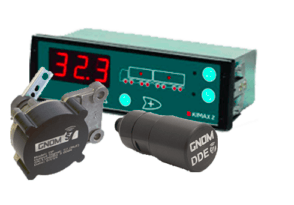Ruptela Axle Weight Monitoring Sensor
Pivot weight observing sensors are utilized to decide the hub heap of a weighty business vehicle. They empower individuals in control to know the specific load of the vehicle with/without freight, help to stay away from potential fines for over-burdening the vehicle, and lessen support costs connected with consistent over-burdening.

Ruptela Axle weight monitoring sensors play a crucial role in assessing the axle load of heavy commercial vehicles. These sensors provide accurate information about the vehicle’s weight, whether loaded or empty. This knowledge empowers decision-makers to prevent potential fines associated with overloading and minimizes maintenance expenses resulting from persistent overloading.
Compatibility: These sensors seamlessly integrate with a range of tracking devices, including HCV5, LCV5, Pro5, and FM-Pro4, ensuring versatility and adaptability across various vehicle models.
Understanding the significance of axle weight is vital for effective fleet management. These sensors not only offer real-time insights into the vehicle’s weight dynamics but also contribute to regulatory compliance, preventing penalties and optimizing maintenance costs.
Key Benefits of Ruptela Axle Weight Monitoring Sensor:
- Precision in Weight Measurement: Axle weight monitoring sensors provide precise measurements, allowing fleet managers to have an accurate understanding of the vehicle’s weight under different conditions, whether it’s carrying a load or traveling empty.
- Compliance and Fine Avoidance: By having real time information on axle loads, fleet operators can ensure compliance with weight regulations. This proactive approach helps avoid fines and penalties associated with overloading, contributing to a smoother and more cost-effective operation.
- Reduced Maintenance Costs: Continuous overloading puts significant stress on a vehicle’s components, leading to increased wear and tear. Axle weight monitoring helps prevent unnecessary strain, reducing maintenance costs and extending the overall lifespan of commercial vehicles.
- Enhanced Safety: Proper weight distribution is crucial for road safety. Monitoring axle weights ensures that vehicles operate within safe weight limits, reducing the risk of accidents caused by imbalanced loads.
- Versatile Compatibility: These sensors are compatible with a range of tracking devices, offering flexibility for fleet managers.
In conclusion, the integration of axle weight monitoring sensors is a strategic move for any fleet management strategy. These devices not only provide critical weight data but also contribute to legal compliance, cost effectiveness, and overall operational safety. Their compatibility with popular tracking devices, such as HCV5, LCV5, Pro5, and FM-Pro4, makes them a valuable asset for a diverse range of heavy commercial vehicles.
Integration of the device is subject to the terms and conditions of our software.